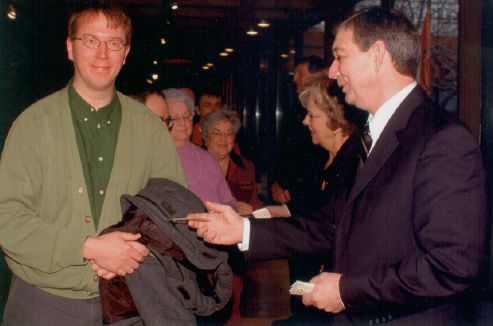The sidewalks along the east side of University Avenue hadn’t been plowed as of noon today (I’m not complaining, just commenting: there’s one hell of a lot of snow to get moved, and the City is doing an admirable job). Here’s what it looked like:

On the left: my boots and Catherine’s snowshoes after my 15 foot attempt to get to work. On the right: the view out our front door of our neighbour’s compost bins, left in the driveway.

|

|
There is a mighty storm happening around us. This isn’t some sort of minor-league “a little snow” kind of storm: it’s a “we can’t open our front door” storm. No snow plows. No police. Tried to get to work, but turned back after about 15 feet. So far, though, we have power. Will hunker down and watch the SponsorGate hearings on Newsworld.
Okay, this is cool: Teleport lets you use one keyboard and mouse to control two Macs, over Ethernet. It’s impossible to do justice to how useful it is until you’ve set it up, and have your iMac and iBook side by each. If you have two Macs, you should try it out. [found on MacOSXHints.com]
At the New Years Levee held by Premier Pat Binns, Brian Simpson, the excellent Provincial Photographer, was taking pictures of every attendee. This was a huge challenge, as I’m sure there were at least 500 citizens paying their respects.
About a month after the levee, using some highly sophisticated identity matching system, every person who had their photograph taken received a personal note, signed by the Premier, with a copy of the photo, in the mail.
Here is mine:

Notice several interesting aspects of the photo:
- I am paying attention to the photographer, the Premier is not; as a result, it looks like I’m not paying attention to the Premier.
- I am wearing my famous green cardigan (the one that Ian and the Bishop have complimented me on, and that Daniel seems to think disqualifies me from being able to start a rock band if this web thing doesn’t work out).
- I have a weird grin on my face. This might be partially explained by my partial drunkenness.
- For some reason, I appear to look a lot more like Father Mulcahy than I’m comfortable with.
- The Premier appears to be slipping me a $100 bill. In fact he slipped me a limited edition Prince Edward Island pin.
- My natty green shirt is by Simons Montreal.
If you come a-leveeing next year, you’ll be able to get your very own picture!
Aliant unveils a special “trial” of WiFi, with one hotspot in Charlottetown.
I guess they’re holding off to see if this WiFi thing really takes off.
 Karin LaRonde, as I’ve discussed
here before, runs a business in Charlottetown that delivers healthy meals for lunch.
Karin LaRonde, as I’ve discussed
here before, runs a business in Charlottetown that delivers healthy meals for lunch.
Steven and Daniel and I were talking just now, on the way back from the Formosa, about how what we really need is a healthy snacks delivery service that would bring much needed sustenance during the 3:30 p.m. to 5:00 p.m. post-lunch, pre-dinner catatonia period.
This period, characterized by the dueling inability to make practical decisions and extreme need for food and beverage, is where a no-decisions-required emergency snack delivery service would come in very handy.
Steven and I both realized that our reaction to this catatonia period right now is either to consume unhealthy panic-driven snacks obtained in a mindless rush for food or, more commonly, to simply push on through, thus creating unnecessary levels of snarkiness, inefficiency, and thoughtlessness that often ripple on to affect our ability to eat a proper supper.
We envision a Big Red Button in ones office that, if pressed, would simply cause appropriate provisions to be delivered.
We agreed that we would be willing to pay heartily for this service immediately.
This is a business opportunity waiting for an enterprising person.
Standard practise in the “replies,” “comments,” or “discussion” portion of weblogs is to allow anyone to comment about anything, and to, without proof of identity, enter a name, email and sometimes a website address to attach to their comment.
While there are some systems that require readers to register, sometimes with an emailed password to verify the email address they enter, this is rare, and thought, I think, to be too much of an impediment to free-flowing discussion.
The result of this free-form approach to identity is that it’s impossible to know who is commenting about what. That many readers favour using pseudonyms, or short forms of their names, exacerbates this problem.
Take this thread of discussion about a recent post here: there are comments from “blair,” from me (or at least someone claiming to be me; I happen to know it was me), two from “Rob L.” and one from “Brian.”
Because I give readers the option of not having their email address (approximately 2/3 of commenters choose this option), often all the reader of comments knows is the “handle” the writer used. And there’s no assurance that even the same handle always identifies the same person.
Indeed there was an issue that arose here last year where comments from one reader were subsequently read by another reader, with the same first name and last initial. This person took umbrage, feeling that if the comments were seen to have come from him, he would suffer harm.
Mistaken (or hijacked) identity is only one of several ramifications of this situation: not knowing, with any certainty, who is the writer of commentary diminishes their authority, strips them of context, and makes for confusing lines of responsibility.
Another example: if an anonymous person, using a pseudonym, writes a comment here that defames someone, who is ultimately responsible? My first reaction is that everyone owns, and is responsible for, their own words. But what if the writer can’t be identified, either publically or privately?
What, if anything, should we do about this?

 I am
I am